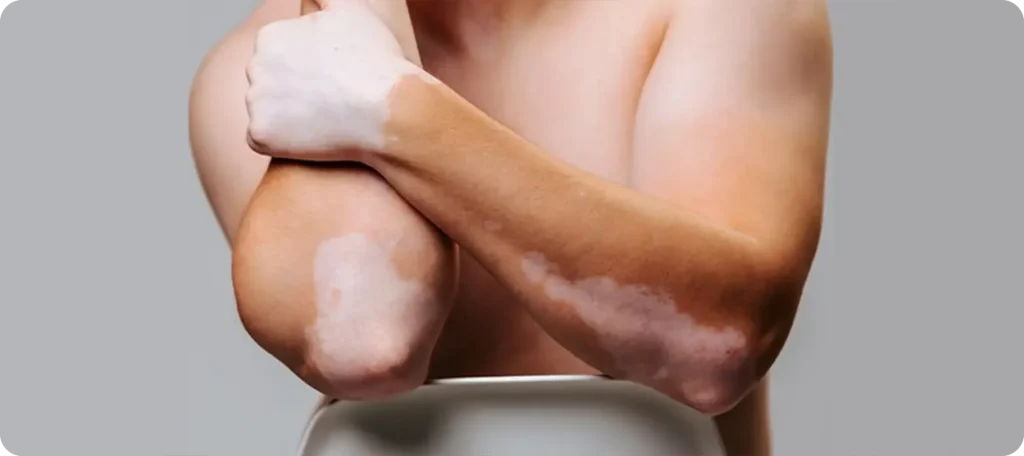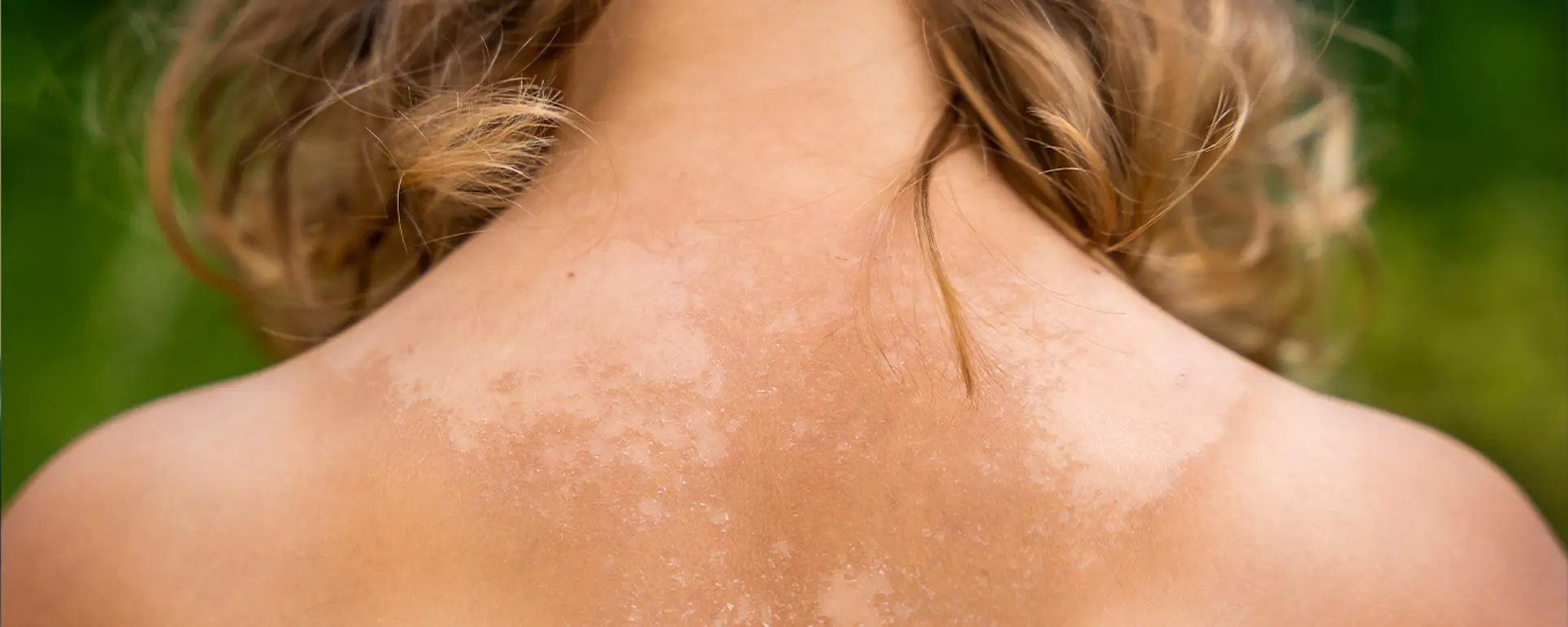Have you ever looked in the mirror and noticed a pale patch or white spot on your skin, only to find yourself wondering, “Is this normal?” If so, you’re not alone. White spots on the skin are more common than you might think. They can appear on the face, arms, legs, back or just about anywhere and they affect people of all ages and skin tones.
In many cases, these spots are completely harmless and nothing to worry about. They might be caused by something as simple as dry skin, a minor fungal infection, or sun exposure. But in other cases, they could signal an underlying condition that needs a bit more attention, such as vitiligo, tinea versicolor, or a nutritional deficiency.
Understanding what’s going on with your skin can feel confusing, especially when the changes seem to come out of nowhere. That’s why I’ve put together this detailed guide to help you make sense of those mysterious white patches. I’ll walk you through some of the most common reasons they appear, how dermatologists go about diagnosing the issue, and the signs that it might be time to get professional help.
Whether you’re dealing with a single spot or several, knowing the potential causes is the first step to getting clarity and peace of mind.
What Do White Spots Actually Mean?
White or pale patches on the skin can be a little unsettling when you first notice them. You might assume it’s just dry skin or a reaction to something new in your routine but in many cases, these spots are the result of changes in pigmentation. In simple terms, pigmentation refers to the colour of your skin, which is produced by a natural pigment called melanin.
When certain areas of your skin start producing less melanin or none at all it leads to lighter patches that stand out from the rest of your skin tone. This process is known as hypopigmentation, and it’s usually a sign that something is interfering with melanin production or distribution in that specific area.
Now, not all white spots are the same, and they don’t all point to the same cause. Some are short-term and reversible, caused by things like fungal infections or healing skin. Others may be signs of long-term conditions like vitiligo, which is a more chronic autoimmune disorder. In rare cases, white patches could indicate underlying health issues, including deficiencies or immune responses.
The key takeaway? A white patch doesn’t always mean something serious, but it does mean that your skin is trying to tell you something. Understanding the underlying cause is the first step toward managing or even reversing the change.
So, what exactly could be behind these pigment changes? Let’s break down the most common conditions that lead to white or pale patches on the skin.
Common Causes of White Spots on the Skin
1. Vitiligo

Vitiligo is one of the most well-known causes of white patches on the skin. It’s a chronic autoimmune condition in which the body’s immune system mistakenly targets and destroys melanocytes the specialised cells responsible for producing melanin, the pigment that gives your skin its colour. As a result, the affected areas lose pigment and appear as pale or completely white patches.
This condition can begin at any age, but it often first appears before the age of 30. It commonly starts around the mouth, eyes, hands, elbows, knees, or feet areas where the skin is more exposed to friction or movement. Over time, the patches may stay in one place or slowly spread to other parts of the body.
Vitiligo is not contagious, painful, or physically harmful, but it can significantly impact a person’s emotional wellbeing, especially if the patches are on visible areas like the face or hands. People with darker skin tones may notice the contrast more clearly, which can lead to social anxiety or lowered self-esteem.
2. Tinea Versicolor
Tinea versicolor also known as pityriasis versicolor is a very common skin condition caused by an overgrowth of Malassezia, a type of yeast that naturally lives on our skin. While this yeast is usually harmless, certain factors can cause it to multiply excessively, disrupting the normal pigmentation process in the skin.
This condition typically results in small, scaly patches that can appear lighter or darker than the surrounding skin. In people with darker complexions, the patches often look pale or white, while in lighter skin tones, they may look slightly pink or brown. These patches are most commonly seen on the chest, back, shoulders, and upper arms, though they can also appear on the neck or even the face in some cases.
What makes tinea versicolor especially noticeable is how it reacts to sun exposure. The yeast interferes with melanin production, which means the affected areas don’t tan normally. As a result, the contrast between tanned and untanned skin becomes more obvious after spending time in the sun, making the white patches stand out even more.
3. Pityriasis Alba
Pityriasis alba is a common skin condition, especially in children and adolescents, and is often considered a mild form of eczema (also known as atopic dermatitis). The name “pityriasis” refers to the fine, flaky scales that often appear on the patches, while “alba” means white describing the pale appearance of the affected skin.
This condition typically shows up as light-coloured or pale patches with slightly dry or scaly texture. The patches are usually round or oval in shape and most commonly appear on the face, particularly the cheeks and chin. However, they can also be seen on the neck, upper arms, and shoulders. The skin may look a little rough or dry, but it’s usually not itchy or painful.
Pityriasis alba tends to become more noticeable after sun exposure, as the affected patches don’t tan the same way as surrounding skin. It’s also more visible in people with medium to dark skin tones, where the contrast between normal and lighter skin is more pronounced.
4. Post-Inflammatory Hypopigmentation (PIH)
Post-inflammatory hypopigmentation (PIH) is a common cause of white or lighter patches that appear after the skin has experienced inflammation or injury. It can occur in response to conditions such as acne, eczema, psoriasis, burns, insect bites, or even cosmetic procedures like chemical peels or laser treatments.
What happens is that the inflammation disrupts melanin production in the skin. When the area begins to heal, the skin may temporarily lose pigment, leaving behind a lighter patch than the surrounding skin. This is different from post-inflammatory hyperpigmentation, which causes dark marks though both are related to the skin’s healing process.
PIH is more noticeable in medium to dark skin tones, where any contrast in pigmentation is more pronounced. While it might look concerning, these patches are usually not permanent. In most cases, the pigment will gradually return over time as the skin’s melanin production balances out again. This process can take several weeks to months, depending on the extent of the inflammation and your skin type.
5. Idiopathic Guttate Hypomelanosis
Idiopathic guttate hypomelanosis (IGH) may sound like a mouthful, but it’s actually a very common and harmless skin condition, particularly among people over the age of 40. The term breaks down like this:
- Idiopathic means the exact cause is unknown
- Guttate refers to the drop-like shape of the spots
- Hypomelanosis indicates a reduction in melanin or skin pigment
IGH typically presents as tiny white spots, usually between 2–5 mm in diameter, that appear on sun-exposed areas like the forearms, shins, and sometimes the shoulders or upper back. These spots are smooth, non-scaly, and don’t itch or hurt. Most people notice them gradually increasing in number with age.
While the cause isn’t fully understood, IGH is thought to be related to chronic sun exposure over time. Ultraviolet (UV) radiation may damage the skin’s melanocytes, leading to small patches where melanin production is reduced or absent. It’s also associated with ageing, which is why it’s sometimes referred to as a sign of “sun damage” or photoaging.
When to See a Dermatologist

Not every white spot on your skin needs medical attention many are completely harmless and may fade on their own over time. However, in some cases, those pale patches could be a clue that something more is going on beneath the surface. Knowing when to seek professional help can save you time, worry, and in some cases, prevent the condition from worsening.
So, when should you consider making that dermatologist appointment? Here are some key signs:
- The spots are spreading, growing in number, or changing shape or texture: If new patches keep appearing or existing ones are expanding quickly, it could be a sign of an active skin condition that needs treatment.
- The area is itchy, flaky, scaly, or irritated: While many white spots are symptomless, any discomfort like itchiness, dryness, or inflammation may point to conditions like tinea versicolor, eczema, or lichen sclerosus.
- You’re not sure what’s causing the patches: If you’ve tried home remedies or over-the-counter products without success or if the patches appeared suddenly and aren’t improving it’s best to get a proper diagnosis.
- The patches are affecting your confidence or mental wellbeing: Even if a condition is medically harmless, noticeable changes in your skin can still impact your self-esteem, especially if the patches are on visible areas like the face, hands, or arms. A dermatologist can help you manage the cosmetic aspects in a way that makes you feel more comfortable.
- You have a history of autoimmune or chronic skin conditions: If you or your family members have conditions like vitiligo, psoriasis, or eczema, it’s a good idea to have new skin changes checked sooner rather than later.
How Dermatologists Diagnose White Spots
When it comes to white spots on the skin, getting a clear and accurate diagnosis is the first and most important step. That’s because different causes of pigment loss often look very similar on the surface, even though they require completely different treatments. A dermatologist’s job is to determine why the patches are there, what’s causing them, and how best to treat them (if treatment is needed at all).
The process usually begins with a thorough visual examination. Your dermatologist will look closely at the size, shape, colour, and location of the patches. They may also ask questions about your medical history, family history, skin care routine, and how long the spots have been present. Details like recent sun exposure, previous skin injuries, or any symptoms like itching or scaling can provide helpful clues.
In some cases, a visual inspection is enough to make a diagnosis. But if more information is needed, your dermatologist might use one or more of the following tools:
- Wood’s lamp examination: This is a handheld device that emits ultraviolet (UV) light. When shone on the skin in a dark room, it can reveal subtle differences in pigmentation that aren’t always visible to the naked eye. For example, vitiligo often shows a bright white glow under the lamp, which helps distinguish it from other conditions.
- Skin scrapings: If a fungal infection like tinea versicolor is suspected, your dermatologist may gently scrape a small sample of skin from the affected area. This can be examined under a microscope or cultured in a lab to confirm the presence of yeast or fungi.
- Skin biopsy: In cases where the cause of the white patches is unclear, your doctor might take a tiny sample of skin (usually under local anaesthesia) for closer examination under a microscope. This can help rule out or confirm conditions like lichen sclerosus, autoimmune disorders, or rare skin diseases.
- Blood tests: If there are signs that an autoimmune condition may be involved such as vitiligo or thyroid disorders your dermatologist may recommend a blood test to check for specific antibodies or imbalances in your immune system.
Accurate diagnosis is crucial not just to identify the cause, but also to avoid unnecessary or ineffective treatments. For example, using antifungal creams on a non-fungal condition like vitiligo won’t help and might even delay proper care. By pinpointing the right cause early on, your dermatologist can create a personalised treatment plan that gives you the best chance of managing or reversing the pigmentation changes.
Treatments That Can Help

The best treatment for white spots depends entirely on the underlying cause. A dermatologist will tailor the approach based on your specific diagnosis, skin type, and how much the condition is affecting your daily life. Here’s what treatment might look like for each condition:
For Vitiligo:
- Topical corticosteroids or calcineurin inhibitors to reduce inflammation and help restore pigment in early stages.
- Phototherapy using narrowband UVB light, especially for widespread or stubborn patches.
- Camouflage makeup or skin dyes can provide temporary coverage and boost confidence.
For Tinea Versicolor:
- Antifungal creams, shampoos (like selenium sulphide), or oral antifungal tablets to clear the yeast overgrowth.
- Regular exfoliation and anti-fungal body washes can help prevent future flare-ups, especially in humid weather.
For Pityriasis Alba:
- Moisturisers and gentle skincare products to soothe and hydrate the skin.
- Mild topical steroidcreams may be used occasionally to reduce inflammation if dryness is severe.
For Post-Inflammatory Hypopigmentation (PIH):
- Topical retinoids or azelaic acid to speed up skin cell turnover and support repigmentation.
- Laser therapy may be considered in more persistent or long-standing cases, under dermatological guidance.
For Idiopathic Guttate Hypomelanosis:
- No treatment is usually necessary, as the condition is harmless and purely cosmetic.
- Cryotherapy, dermabrasion, or fractional laser treatments might offer improvement if the spots are bothersome.
Always consult a dermatologist before starting any treatment especially when dealing with pigment disorders, where incorrect or harsh products can sometimes make things worse.
Can You Prevent White Spots?
While not all white spots can be prevented especially those linked to genetics or autoimmune conditions adopting healthy skincare habits can help minimise your risk and reduce their appearance. Prevention largely depends on protecting your skin and supporting its natural barrier. Here are a few simple, effective steps:
- Moisturise daily to keep the skin barrier strong and resilient. Well-hydrated skin is less prone to dryness, irritation, and conditions like pityriasis alba or eczema.
- Apply sunscreen every day, especially to areas frequently exposed to the sun. This helps prevent sun-induced contrast between pigmented and lighter areas and reduces the risk of conditions like tinea versicolor or guttate hypomelanosis.
- Avoid over-scrubbing or using harsh products, which can damage the skin and increase the chance of irritation or post-inflammatory hypopigmentation.
- Treat skin issues early, whether it’s acne, rashes, or fungal infections. Prompt care helps reduce inflammation and lowers the risk of pigmentation changes after healing.
While you can’t always control the root cause, maintaining a gentle, protective skincare routine gives your skin the best chance of staying healthy and even-toned.
Final Thought: Understanding the Cause Is the First Step to Clearer Skin
White spots on your skin don’t always mean something serious, but they do deserve attention. Whether it’s a harmless fungal patch or an autoimmune condition, early diagnosis leads to better outcomes.
You can get in touch with us to book a consultation with one of our expert dermatologists in London. We’ll help you uncover the cause and build a plan to restore your skin tone with confidence.
References:
- Łabędź, N., Navarrete-Dechent, C., Kubisiak-Rzepczyk, H., Bowszyc-Dmochowska, M., Pogorzelska-Antkowiak, A. and Pietkiewicz, P. (2023) ‘Pityriasis Versicolor A Narrative Review on the Diagnosis and Management’, Life, 13(10), p. 2097.
Available at: https://www.mdpi.com/2075-1729/13/10/2097 - Brown, F. and Crane, J.S. (2022) ‘Idiopathic Guttate Hypomelanosis’, StatPearls [Internet]. Treasure Island (FL): StatPearls Publishing. Available at: https://www.ncbi.nlm.nih.gov/books/NBK482182/
- Wood, L. (1991) ‘Pityriasis alba’, Pediatric Clinics of North America, 38(4), pp. 839–847.
Available at: https://www.sciencedirect.com/science/article/abs/pii/S0031395505701687 - Krüger, C. and Schallreuter, K.U. (2012) ‘Vitiligo: a comprehensive overview’, Clinical, Cosmetic and Investigational Dermatology, 5, pp. 205–223.
Available at: https://www.ncbi.nlm.nih.gov/pmc/articles/PMC3512492/ - Rodrigues, M., Antunes, J., Vitório, M., Rosário-Fernandes, F., Cairrao, E. and Cascão, M. (2020) ‘Tinea versicolor: an updated review’, Dermatology Online Journal, 26(1), Article ID: 13030. Available at: https://www.ncbi.nlm.nih.gov/pmc/articles/PMC9677953/
